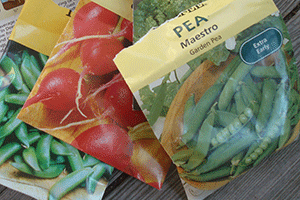Lots of gardeners receive several seed catalogs each winter. In the past few years, many companies have converted to an electronic version; if you’ve ever ordered from them online, your email box is probably receiving a special offer once a week or so. All of this activity is taking place just at the time when cabin fever is at an all-time high, causing much temptation. As you peruse the pages, how can anyone make up their mind over what to buy…there’s probably something that you want on every page!
The following will help both disciplined and susceptible gardeners alike:
- Inventory the seed that you have on hand. Most garden seeds will grow well a second or third year, with the exception of parsnips, corn and onion.
- Make a list of the flowers and veggies that you want to include in the garden. Refer back to your master plan (if you don’t have one, make one) and use it as a guide. Also, ask you family members what they like to see or eat. There’s no sense in planting radishes if no one in the house likes them.
- Consult the catalogs with list in hand. This is an important distinction, much like going grocery shopping with the grocery list in hand, as well as after you’ve eaten lunch. These 2 strategies will help reduce the number of unnecessary and/or spontaneous purchases.
- Read, read, read. Read the descriptions of each offering closely. If the plant won’t grow in our area, it’s a waste of time and money no matter how good it sounds. Look for preferred growing requirements, such as sun/shade preference, length to harvest, height and width, soil moisture needs.
- Pictures are helpful. Shy away from, or at least check out an offering with Google Images, Yahoo Image Search or MSN Photos. Look for color and texture of foliage and flowers. Look for compatibility with the existing plants you might have nearby. Searching for visual information will help in the selection process.
- Make a selection, then keep a running total. As the items are chosen, and the associated cost is marked down, the tabulation is rising and rising. This is good, as it has a natural prioritizing effect; hm…maybe I don’t need item 3 or 9 as much as I initially thought I did. Keep the overall budget in mind during the final selection process.
- Save a few dollars for something new, something quasi-experimental. Perhaps something that is whimsical, or very practical; perhaps something that a friend recommended or bears the AAS seal of distinction.

